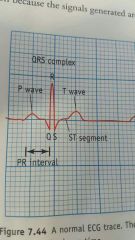![]()
![]()
![]()
Use LEFT and RIGHT arrow keys to navigate between flashcards;
Use UP and DOWN arrow keys to flip the card;
H to show hint;
A reads text to speech;
17 Cards in this Set
- Front
- Back
- 3rd side (hint)
|
What is aerobic capacity? |
The ability to take in, transport and use oxygen |
|
|
|
What is VO2? |
When we are rest we consume 0.2-0.3 litres of oxygen per minute |
|
|
|
What is VO2(max) ? And the units |
This is the max amount of oxygen consumed per minute during aerobic exercise. ml min-1 kg-1 |
|
|
|
What is VO2 max dependent on? |
The efficiency of uptake and delivery of oxygen by the lungs and cardiovascular system and the efficient use of oxygen in the muscle fibres. So a fit person can work for longer at a higher intensity using aerobic respiration without accumulating lactate than someone who doesn't undertake regular exercise |
|
|
|
What is cardiac output? |
Volume of blood pumped by the heart in a minute |
|
|
|
When running, what is adequate oxygen supply maintained by? |
Increasing cardiac output Faster (ventilation rate) rate of breathing - to obtain more oxygen and to get rid of more carbon dioxide Increasing heart rate - to deliver oxygen to the muscles faster and remove extra CO2 produced by the increased rate of respiration in muscle cells |
|
|
|
What is cardiac output dependent on? |
The volume of blood ejected from the left ventricle (the stroke volume) Heart rate
|
|
|
|
What is the equation for cardiac output |
Stroke volume (SV) x Heart rate (HR) |
|
|
|
What is a venous return? |
When there is greater muscle action due to exercise so more blood returns to the heart. |
|
|
|
In diastole during exercise what happens to the heart? |
The heart fills with a larger volume of blood The heart is stretched to a greater extent, causing it to contract with a greater force , and so more blood is expelled. This increases stroke volume and cardiac output. |
|
|
|
What does it mean for the heart muscle to be myogenic? |
It means it can contract without external simulation |
|
|
|
How does the heart beat? |
1) Electrical impulses from the SAN (sinoatrial node) spread across the atria walls, causing contraction of both atrium. This is called atrial systole. 2) Impulses pass to the ventricles via the AVN after a short delay to allow time for the atria to finish contracting 3) Impulses pass down the Purkyne fibres to the heart apex 4) The impulses spread up through the ventricle causing contraction from the apex upwards. Blood is squeezed into the arteries. This is ventricular systole. |
|
|
|
Why is there a delay of the impulse between the SAN and AVN |
Because the delay ensures that the atria have finished contracting and that the ventricles have filled with blood before they contract. |
|
|
|
How can you measure electrical activity of the heart? |
The electrical currents caused by the spread of the electrical impulse during the cardiac cycle can be detected with an electrocardiogram (ECG). |
|
|
|
Explain the different peaks in ECG trace |
P wave - depolarisation of the atria, leading to atrial contraction (atrial systole) PR interval - the time taken for impulses to be conducted from the SAN across the atria to the ventricles through the AVN QRS complex - the wave of depolarisation resulting in contraction of the ventricles (ventricular systole) T wave - repolarisation of the ventricles during the hearts relaxation phase (diastole) |

|
|
|
By using a ECG trace, how could you diagnose if a patient has Tachycardia - increased heart rate? In addition what could results from the heart condition? |
The heartbeat would be too fast This is a sign of heart failure, as the heart can't pump blood efficiently, so heart rate increases to pump blood around the body. This can increase the chance of a heart attack |
|
|
|
How does the ventilation centre control the rate and depth of breathing during the exercise? |
1) It controls the rate and depth of breathing in response to impulses from chemoreceptors in the medulla and arteries which detect the pH and concentration of CO2 in the blood. 2) Impulses are sent to stimulate the muscles inclined involved in breathing. 3) A small increase in CO2 concentration causes a large increase in ventilation. It also increases in response to impulses from the motor cortex and from stretch receptors in tendons and muscles involved in movement. |
|

